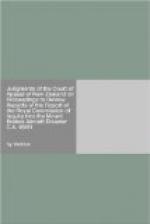as the aircraft levelled out at 3000 feet and
then later at 1500 feet was a long vista of flat snow-covered
terrain, extending ahead for miles. Similarly,
the roof of the solid overcast extended forward
for miles. In the far distance the flat
white terrain would either have appeared to have reached
the horizon many miles away or, more probably, merged
imperceptibly with the overhead cloud thus producing
no horizon at all. What the crew could see,
therefore, was what appeared to be the distant
stretch of flat white ground representing the flat
long corridor of McMurdo Sound. In reality
the flat ground ahead proceeded for only about
6 miles before it intercepted the low ice cliff
which marked the commencement of the icy slope leading
upwards to the mountain, and at that point the
uniform white surface of the mountain slope proceeded
upwards, first at an angle of 13 deg., and then
with a gradually increasing upward angle as it merged
with the ceiling of the cloud overhead. The only
feature of the forward terrain which was not
totally white consisted of two small and shallow
strips of black rock at the very bottom of the ice
cliff, and these could probably not be seen from the
flight deck seats owing to the nose-up attitude
of 5 deg. at which the aircraft was travelling,
or they were mistaken for thin strips of sea
previously observed by the crew as separating blocks
of pack ice.
The aircraft had thus encountered, at a fateful coincidence in time, the insidious and unidentifiable terrain deception of a classic whiteout situation. They had encountered that type of visual illusion which makes rising white plateaux appear perfectly flat. This freak of polar weather is known and feared by every polar flier. In some Arctic regions in the Canadian and in the north European winter, it is responsible for numbers of light aircraft crashes every year. Aircraft fly, in clear air, directly into hills and mountains. But neither Captain Collins nor First Officer Cassin had ever flown at low altitude in polar regions before. Even Mr Mulgrew [the commentator for the passengers], with his antarctic experience, was completely deceived. The fact that not one of the five persons on the flight deck ever identified the rising terrain confirms the totality of this weird and dangerous ocular illusion as it existed on the approach to Mt. Erebus at 12.50 p.m. on 28 November 1979.
Paragraph 165 of the Commissioner’s report also merits quotation. We have underlined some of it, indicating that in this particular part of his report the Commissioner seems to accept that when they first heard of the crash the management of the airline must have been unaware of the true nature and danger of a whiteout. If so, they would have had no reason to suppose that the pilot would have elected to fly at such a low level without real visibility. That is an aspect which could well have been strongly relied on if, when giving evidence before the Commissioner, they had realised that they were being accused of trying to cover up the cause of the crash from an early stage:




